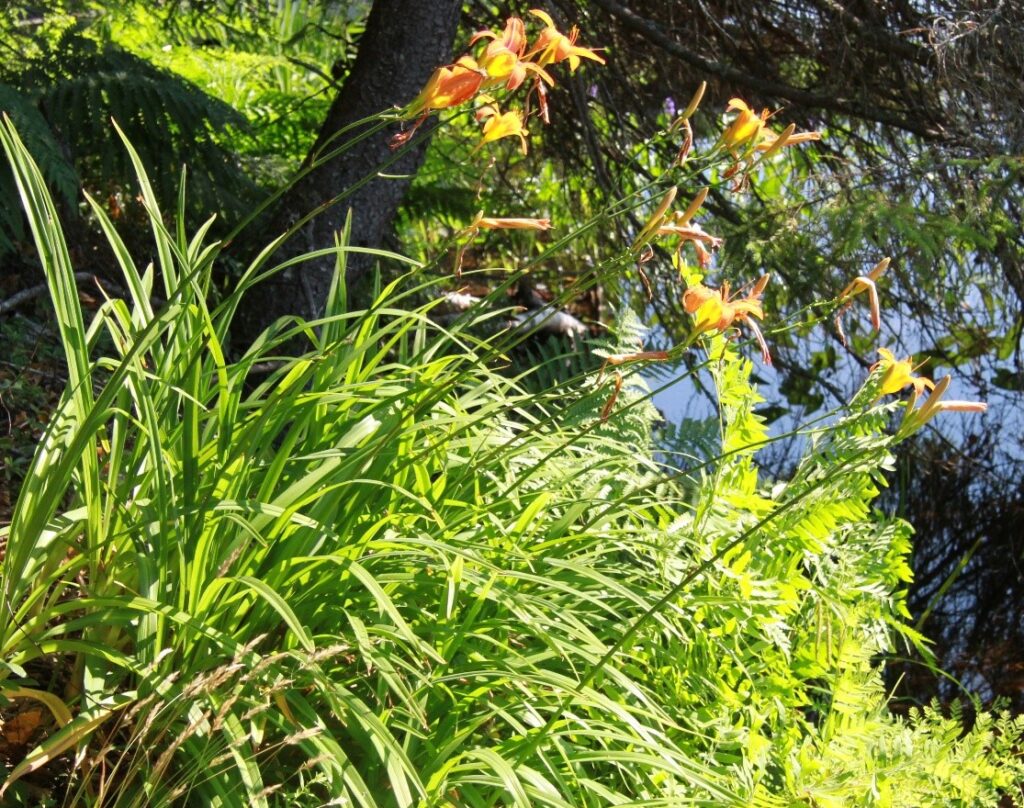
The Concepts and Controversies of Introduced Species / Invasive Plants
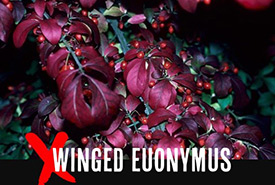
Burning Bush invades a forest understory such as those in High Park, Toronto, ON – (Photo NatureConservancy.ca)
It is the policy of Master Gardeners of Ontario to encourage the removal of invasive species and to suggest planting alternatives for known invasives. While few will dispute the need to remove plants like dog-strangling vine, common buckthorn, phragmites, or garlic mustard, some balk at suggestions that favourites like Norway maple (Acer platanoides), Russian olive (Elaeagnus angustifolia) Burning Bush (Euonymous altatus), Periwinkle (Vinca Minor), Lily of the Valley (Convallaria majalis), Scilla (Scilla siberica), Miscanthus (Miscanthus sinensis) or English ivy (Hedera helix) should be removed. (See CVC Priority Invasive Plant Lists)
We need to talk about this and grow together in our understanding.
First the basics. What is an invasive plant?
There are various definitions, but at its most basic, an invasive plant is an alien species whose introduction does or is likely to cause economic or environmental harm or harm to human health. Not all introduced species are harmful. The majority of Ontario’s food crops are alien species. Many horticultural plants do not show up on any invasive species list, but a surprising 40% of exotic plant species in Canada are classified as weedy or invasive.
According to our Canadian Food Inspection Agency, “There are approximately 3,858 native vascular plant species in Canada. In addition, there are 1,229 alien vascular plant species reported at present in one or more locations in the country, adding up to roughly one-quarter of the national flora. Of these alien vascular plant species, 486 are considered weedy or invasive. Another 316 species are recorded as being native to some part of Canada but introduced into other parts and, of these, 69 are considered invasive. “A few of these are regionally considered significant invaders, such as common ragweed (Ambrosia artemisiifolia) in Quebec, and Manitoba maple (Acer negundo) in Alberta and British Columbia,” (2008. Invasive Alien Plants in Canada: Technical Report. CFIA. Ottawa, ON)
Are they really a problem? Won’t the world’s plants just homogenize anyway?
There are many who suggest that plants move around on their own, so what’s the problem if we assist? We are simply choosing the winners and losers in the game of life, right? But one impact of our movement of plants is becoming apparent.
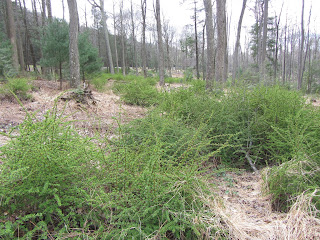
Japanese barberry (Berberis thunbergii) is now listed on the list of invasive species in Ontario. Note: it reverts to the species when it regrows from seed. Image:
Researchers around the globe are recording marked declines in native species. In a recent report from the Intergovernmental Science-Policy Platform on Biodiversity and Ecosystem Services (IPBES) scientists noted that species are declining globally at rates unprecedented in human history. “The numbers of invasive alien species per country have risen by about 70% since 1970, across the 21 countries with detailed records…. Ecosystems, species, wild populations, local varieties, and breeds of domesticated plants and animals are shrinking, deteriorating, or vanishing. This loss is a direct result of human activity and constitutes a direct threat to human well-being in all regions of the world. (2019, “Nature’s dangerous decline ‘unprecedented,’ species extinction rates ‘accelerating’.” United Nations IPBES.) There are multiple causes of this decline: “(1) changes in land and sea use; (2) direct exploitation of organisms; (3) climate change; (4) pollution and (5) invasive alien species.”
The bottom line is that no one really knows the long-term impact of species redistributions, reductions, and extinctions. We can look back over the course of geological time and see that mass extinctions have occurred and life continued. But will people become “dinosaurs”? A more philosophical/ethical question is, do we have the right to displace or eradicate so many other species with which we share this planet? That is a moral dilemma to ponder.
I like my garden plants and they aren’t a problem in my yard.
The questions that consume ecologists and should concern gardeners: Which plants will be invasive? How do we know if a plant will spread from gardens to ecosystems? How fast does it occur? What are the impacts? How can we control or eradicate them before and after they are categorized as invaders? So many questions.

English Ivy (Hedera helix) from a home garden overtaking a ravine area (Photo: The Carbaro Citizen)
Understanding which species will become successful outside their native range is a fundamental question in ecology. Alien species that establish populations in the wild without human intervention are called ‘naturalized.’ The common orange daylily (Hemerocallis fulva) is a good example of a species that has naturalized across North America. When do these naturalized alien plants cross the line and get called ‘invasive’? Typically it is when they displace native species. We often ignore plants that take advantage of disrupted ecosystems like road verges or barren lands. But when daylilies start showing up in conservation lands, as they have done in Ontario, they are red-flagged as problems. How much of a problem they create depends on many factors.
Which invasives do the most harm?
Invasive species tend to be able to reproduce quickly both by seed and vegetatively and can increase their populations rapidly, to the point of excluding native species. The rate and scale of an invasive species movement are used to categorize them from a policy perspective. Which ones are doing the most harm in our region? Given the limitations in funds, time, materials, and labour, ranking species allows people to prioritize control and management activities. All invasive species should be removed, but very simply we need to prioritize and tackle the worst first.
Invasive Honeysuckle Photos from Guelph Mercury
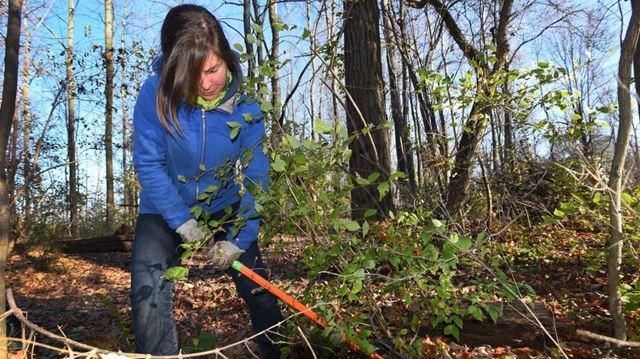

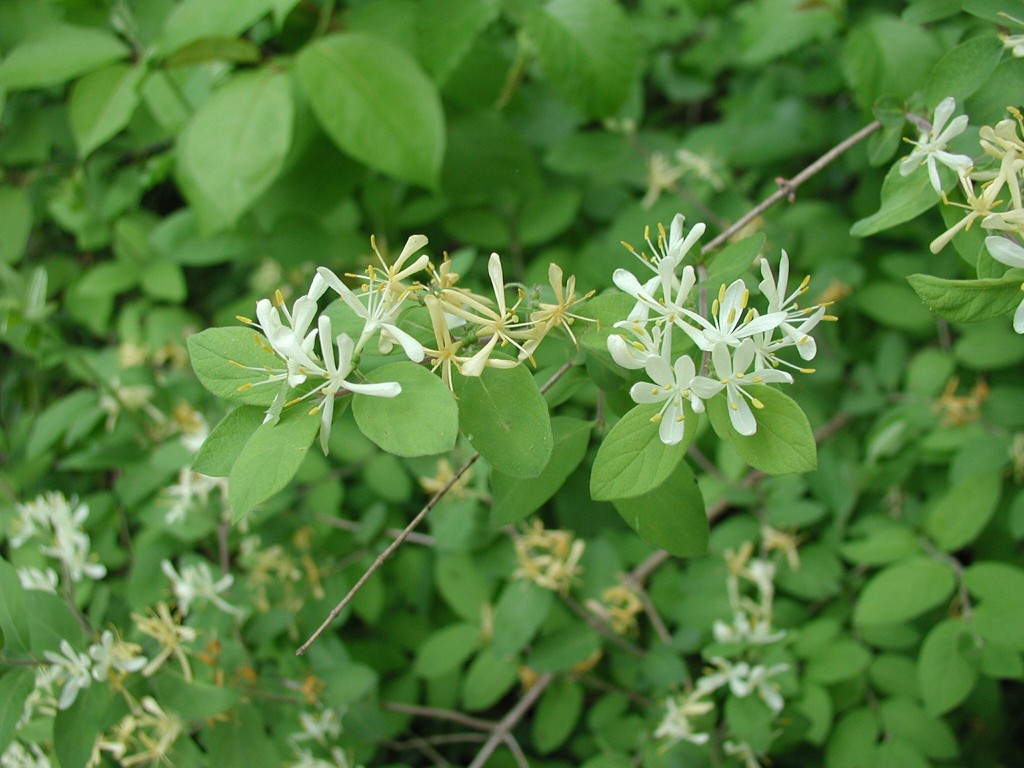
The most noticeable invasive species are those that can grow under a wide range of conditions and are not particular about soil texture, moisture, light, or temperature. Others are more restricted by growing conditions, but in the right area will displace natural species and disrupt ecosystems. Purple Loosestrife (Lythrum salicaria) was introduced as an ornamental plant and for many years seemed well behaved in private gardens. When it made its way into wetlands, however, it became a serious issue. Considerable expense and effort have gone into the management of this garden escapee (now kept in check by the release of biological control agents).
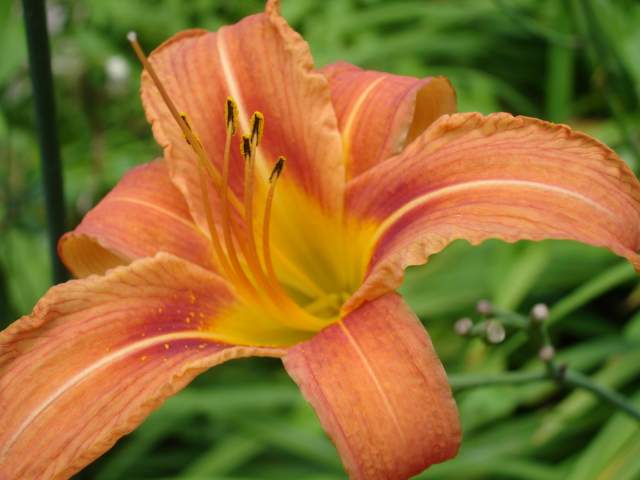
In Ontario Parks Hermocalis fulva (Orange Day Lily) is listed as an invasive species
Using day-lilies as an example, there are over 40,000 cultivars. The common orange ditch lily (Hemerocallis fulva) and the yellow daylily (H. lilioasphodelus) are now considered invasive in many areas of North America. This was not the case 20 years ago. But, as gardeners discarded unwanted clumps in natural lands, and seeds traveled from roadside ditches, they have slowly but surely expanded the area of land they occupy. Are all daylily cultivars invasive? No. There are unquestionably sterile clumping forms that have little potential to escape gardens. However, we have few systems in place to screen cultivars and it is not always clear from observation in a garden setting how they will behave in a natural meadow or a wetland, or a forest.
So What Should We do
We encourage gardeners to select native species for the bulk of their plantings and avoid introduced species that have the potential to become aggressive spreaders. We also encourage our growers and the landscape industry to assess and limit the invasiveness of new plant introductions. Anytime a nonnative plant is described as aggressive or a spreader, it should be avoided. It’s just too much risk for us to deal with in the future!
It is overwhelming. For those of us who have gardened for years and now manage gardens of introduced species, it is difficult to know what to do. Many of us would like to continue doing what we have done in the past. It is hard to change. But we can change with each other’s help. We can find new beautiful combinations that are not invasive and contribute to our native biodiversity.

Multiflora Rose root system Image: Univ. of Wisconsin
How we use our yards and create our gardens matters.
Protected or conservation lands are simply not sufficient to protect native diversity. Consider, Ontario’s “Carolinian zone,” known as ecoregion 7E in southern Ontario. It covers approximately 22,000 km2. Ecoregion 7E occupies less than 0.25% of Canada’s landmass, is home to 25% of the population, and yet provides habitat for over 40% of Canada’s plant species. According to the Carolinian Project, “protected areas and conservation lands only comprise 1.5% of the Carolinian zone.” That is simply not enough to secure native biodiversity for future generations.
So what is the harm of one burning bush or one exotic honeysuckle in one yard? Think about thousands of yards with thousands of introduced species across Ontario. Think about how little space we have set aside to protect native species. When our introduced horticultural species creep into conservation lands, they reduce the space where native plants can grow and reduce the populations of species that rely on those native plants for food and shelter.
For these reasons, we recommend removing invasive species from gardens and advise choosing native species when creating or adding to gardens.
Where to begin with removing invasive plants?
If you border on natural lands or water systems, begin at the edges to reduce their movement. Start with small sections so you don’t feel overwhelmed and target the worst spreaders such as these:
Goutweed, Aegopodium podagraria
Manitoba maple, Acer negundo
Norway maple, Acer platanoides
Garlic mustard, Alliaria petiolata
European or black alder, Alnus glutinosa
Japanese barberry, Berberis thunbergii
Oriental bittersweet, Celastrus orbiculatus
Dog-strangling vine, Cynanchum rossicum & C. nigrum
Autumn olive, Elaeagnus umbellata
European spindletree & winged euonymus, Euonymus europaeus and E. alatus
Lesser celandine; fig buttercup, Ficaria verna (syn. Ranunculus ficaria)
Rough, Reed or giant manna grass, Glyceria maxima
English ivy, Hedera helix
Giant hogweed, Heracleum mantegazzianum
Dames rocket, Hesperis matronalis
Himalayan balsam, Impatiens glandulifera
Non-native bush honeysuckles, Lonicera spp.
Creeping jenny/moneywort, Lysimachia nummularia
Purple loosestrife, Lythrum salicaria
Japanese knotweed, Polygonum cuspidatum
Common reed, Phragmites australis
Common & glossy buckthorn, Rhamnus cathartica & R. frangula
Multiflora rose, Rosa multiflora
Periwinkle, Vinca minor
We can make a real difference, working and learning together.
References:
- CVC Priority Invasive Plants
- Plants voted as INVASIVE (though a US list, these 31 plants all are considered highly invasive here).
- Head, L., Larson, B., Hobbs, R., Atchison, J., Gill, N., Kull, C., & Rangan, H. (2015). Living with Invasive Plants in the Anthropocene: The Importance of Understanding Practice and Experience. Conservation and Society, 13(3), 311-318. Retrieved May 6, 2020, from www.jstor.org/stable/26393209
- Kapitza, Katharina & Zimmermann, Heike & Martín-López, Berta & von Wehrden, Henrik. (2019). Research on the social perception of invasive species: A systematic literature review. NeoBiota. 43. 47-68. 10.3897/neobiota.43.31619.
- Marshall, Nadine & FRIEDEL, M. & Van Klinken, Rieks & Grice, Anthony. (2011). Considering the social dimension of invasive species: The case of buffel grass. Environmental Science & Policy – ENVIRON SCI POLICY. 14. 327-338. 10.1016/j.envsci.2010.10.005.McNeely, J.A. ( ed. ) ( 2001 ) The great reshuffling: human dimensions of invasive alien species . IUCN, Gland , Switzerland and Cambridge.
- Shackleton, Ross & Larson, Brendon & Novoa, Ana & Richardson, David & Kull, Christian. (2018). The human and social dimensions of invasion science and management. Journal of Environmental Management. 229. 10.1016/j.jenvman.2018.08.041.
- Snow, Kathleen. (2006). Working with the Horticulture Industry To Limit Invasive Species Introductions. Conservation in Practice. 3. 33 – 38. 10.1111/j.1526-4629.2002.tb00025.x
- Razanajatovo, Mialy & van Kleunen, Mark. (2016). Non-invasive naturalized alien plants were not more pollen limited than invasive aliens and natives in a common garden. Functional Ecology. 30. 10.1111/1365-2435.12633.
- Hettinger, Ned. (2019). Understanding and Defending the Preference for Native Species (Draft) for Bernice Bovenkerk and Jozef Keulartz, eds., Animals in Our Midst: The Challenges of Co-existing with Animals in the Anthropocen
Cover Image: Ontario Parks.com
Related Posts –
Invasive Alien Species – What Can We Do?
Content gathered and edited by Linda Armstrong, London Middlesex Master Gardeners


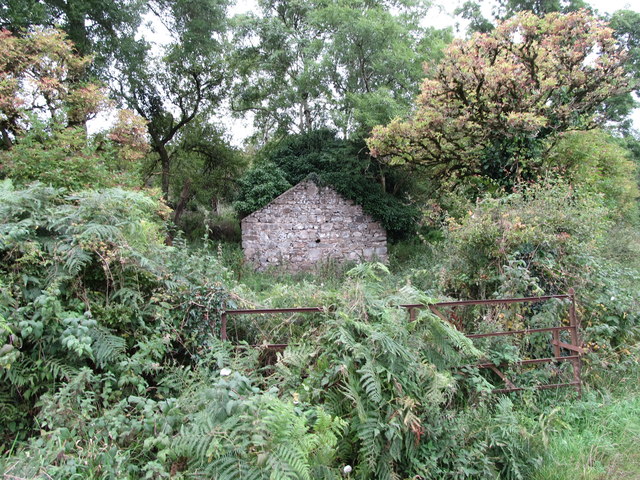
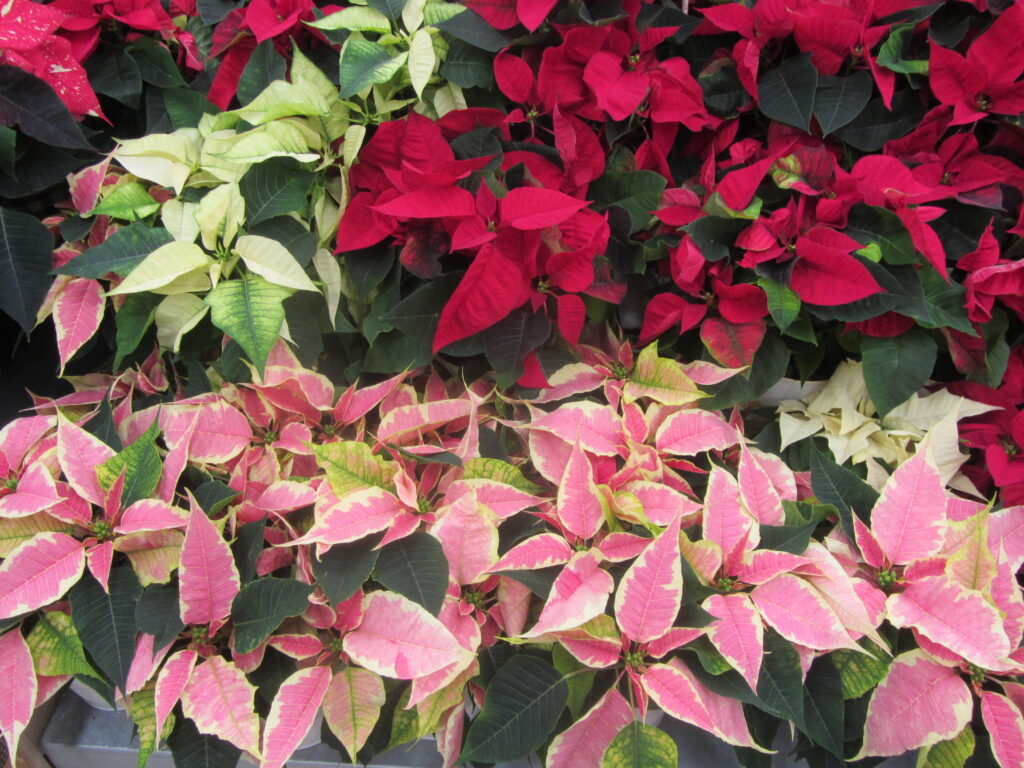
About The Author: Cathy Kavassalis
Catherine Kavassalis is a passionate gardener and conservationist. A former chemist and teacher, she did her doctoral work at M.I.T. and later received a master's in environmental education from the University of Toronto. For fun, she began taking horticulture courses at Guelph University and now is an active member of the Halton Region group of Master Gardeners of Ontario (MGOI) and is an administrator of the MGOI Facebook Group. She was a former President of Oakville Horticultural Society and a former member of the Board of Directors for the Royal Botanical Gardens. Catherine loves to garden and believes that caring for plants is critical for our wellbeing and that of our planet. Catherine enjoys learning and sharing knowledge and by doing so endeavours to stimulate interest and awe in the living world.
More posts by Cathy Kavassalis